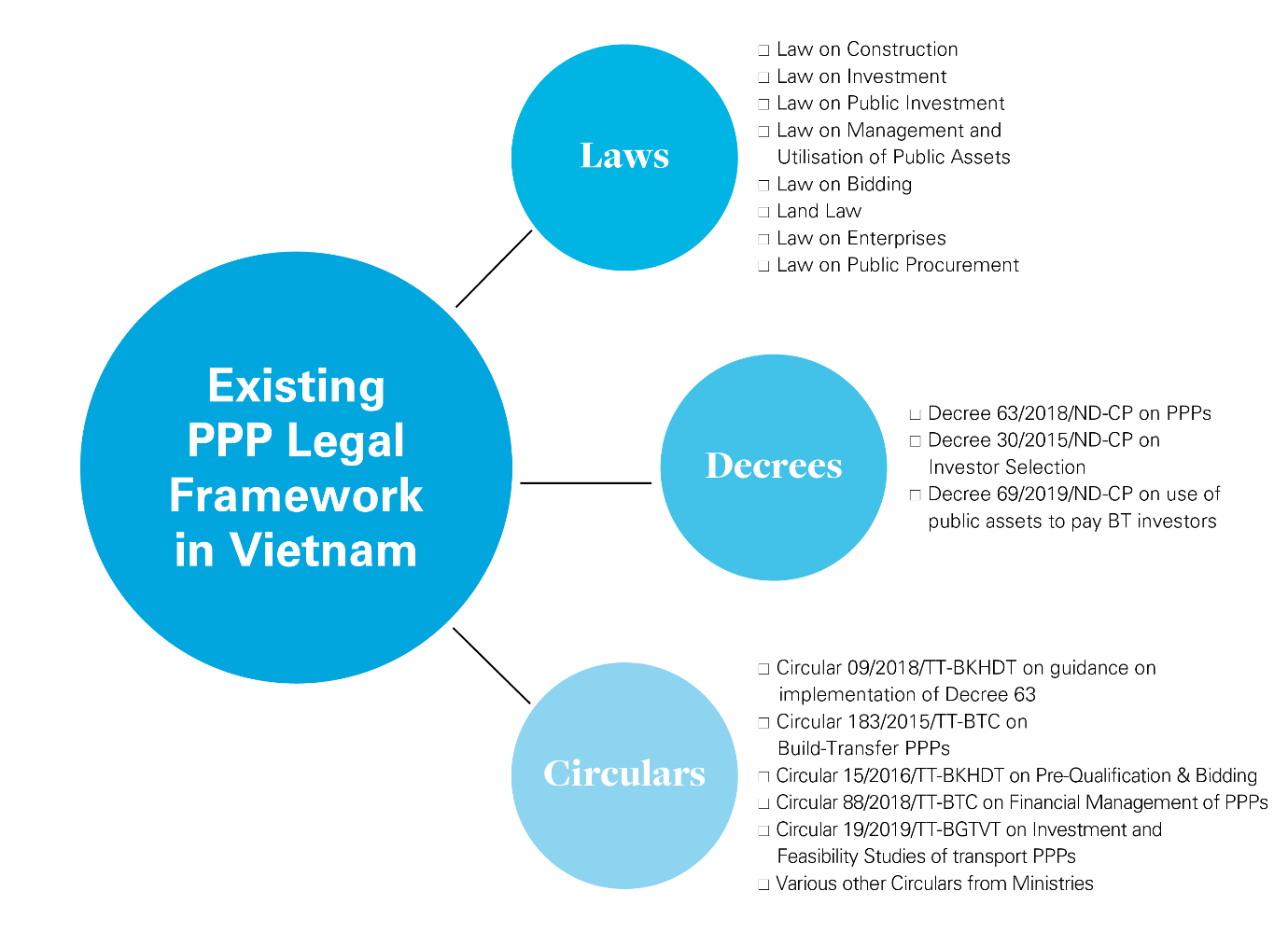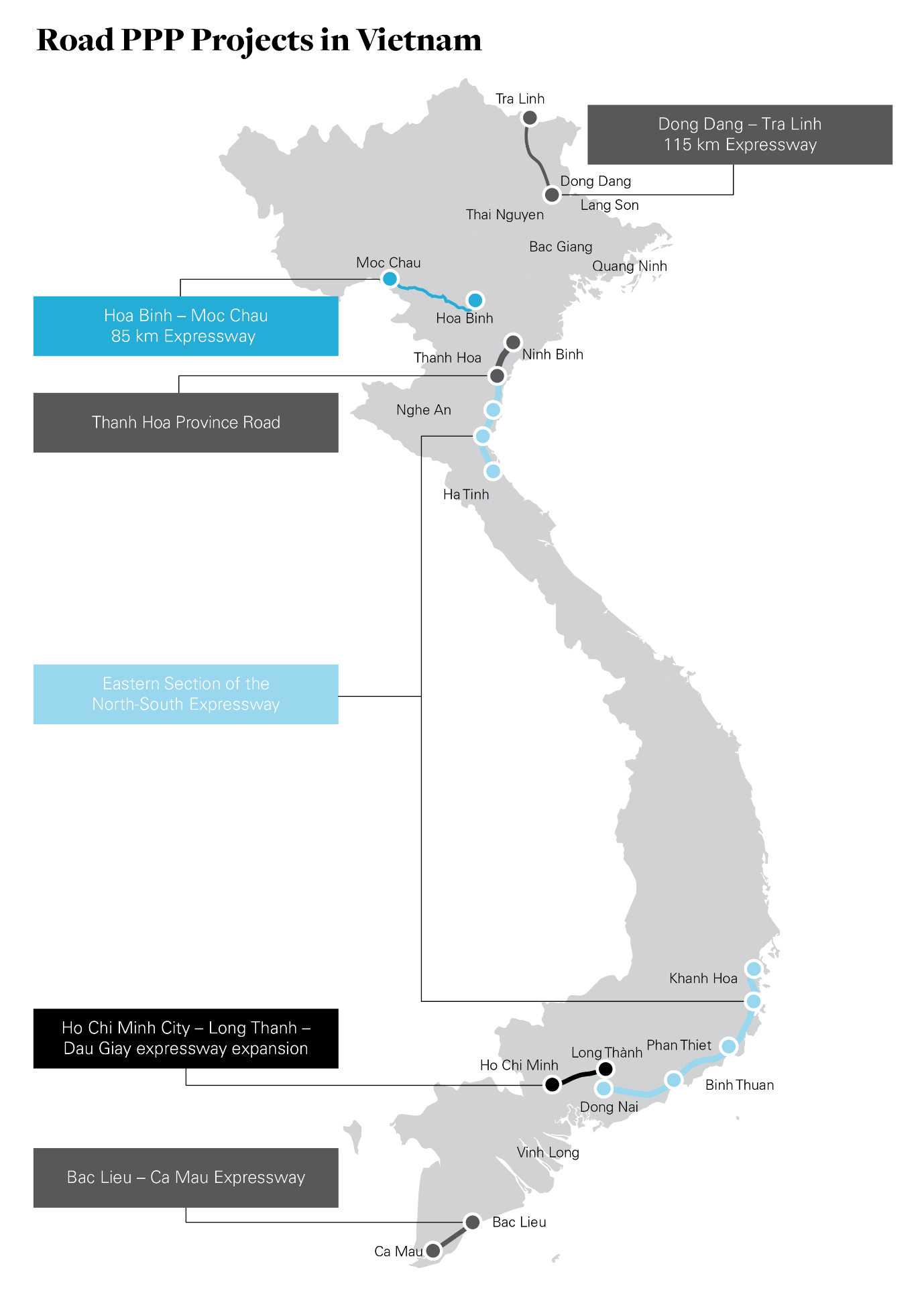
Vietnam's new Law on Public-Private Partnership (Law No. 64/2020/QH14) (the "PPP Law") was ratified on 18 June 2020 by the Vietnamese National Assembly and will come into effect on 1 January 2021.
Prior to the introduction of the new PPP Law, which was first mooted back in 2017, the legal framework in Vietnam in relation to PPPs was found in various legislative instruments as illustrated in the diagram below:
Vietnamese laws are generally drafted in relatively broad terms, with the intention being, in common with many other jurisdictions, that the Government and its ministries implement decrees, circulars and directives to give greater specificity and refinement to the broadly-framed laws. However, with ministries and government departments empowered to independently issue these clarifying regulations, it has been the case in the past that overlapping provisions have led to grey areas and conflicting interpretations resulting in a lack of certainty, particularly for foreign investors seeking robust and predictable frameworks within which to make their capital investments.
In the context of PPP projects, with ring-fenced project financing and long concession periods, a transparent and unified legal framework is preferable in order to facilitate predictable behaviour and decision-making and ultimately, the efficient allocation of risk. The PPP Law, which will become effective on 1 January 2021, represents a consolidation of the existing complex legal framework as well as an evolution in the approach to foreign investment.
A unified, well-developed framework for implementing PPP projects will be crucial if Vietnam is to successfully achieve its significant infrastructure goals and overcome its current infrastructure bottleneck. The application of the PPP Law to upcoming road projects will be a true test of whether enough has been done to address the expectations and concerns of foreign investors, particularly as countries grapple with the consequences of a global pandemic.
New regime
PPPs are not a new phenomenon in Vietnam, however, in the past investors, contractors and financiers have had to navigate a complex framework of legislative instruments to understand the legal provisions applicable to their particular infrastructure project. The introduction of the PPP Law will, for the first time, elevate and codify provisions relating to PPP projects at the law level (as passed by the National Assembly of Vietnam), and in doing so, potentially reduce the uncertainty and ambiguity of the legal framework applicable to a particular infrastructure project.
Whilst this article focuses on the key provisions in the PPP Law, we also note that changes have also recently been made to the Law on Investment and the Law on Enterprises. Notable provisions in the PPP Law include:
- Applicable projects (Article 4) – The PPP Law specifically stipulates five sectors in which PPP investments are permitted, being (i) transportation; (ii) power grids and power plants (except for hydro-power plants and State monopolies as prescribed by the Electricity Law); (iii) irrigation, clean water supply, water drainage, sewerage and waste treatment; (iv) health care and education; and (v) IT infrastructure. To qualify, a project's value must be at least VND 200 billion (approximately US$8.5 million), except for health care and education projects where the threshold is half that amount. The lower threshold also applies to projects within localities with difficult socioeconomic conditions. The permitted sectors for PPP projects prescribed in the PPP Law is much narrower than those expressly permitted under Decree 63. Under the PPP Law, the equity capital contribution of the private investors must be at least 15% of the total investment capital.
- Standard Form Contracts (Article 47) – The Government will provide standard form contracts for use for certain types of project agreements in PPPs (being BOT (build-operate-transfer), BTO (build-transfer-operate), BOO (build-own-operate), O&M (operate-maintain), BTL (build-transfer-lease) and BLT (build-lease-transfer). Importantly, in line with international practice, the PPP Law no longer recognises the BT (build-transfer) model as a form of PPP investment. Although it is unclear as to how detailed these contracts will be and the extent to which commercial negotiation will be permitted by the Government, these documents will hopefully form a useful baseline and streamline procurement processes, noting that it is overly simplistic to seek a ‘one-size-fits-all' approach to PPP risk allocation.
- Bid security (Article 33) – The PPP Law requires investors to lodge bid security (at a rate of between 0.5% and 1.5% of the total project investment value). This bid security is in addition to the general security to secure performance under the PPP documentation (at a rate of 1% and 3% of the project value) and will be forfeited if the investor withdraws from the tender process, violates the bid procedures (where such violation leads to bid cancellation) or if appointed the successful proponent fails to sign the contract documentation within 30 days (other than due to force majeure).
- Government performance guarantees – Unlike Decree 63, the PPP Law does not expressly provide that the Government will grant guarantees in respect of the contractual obligations of State-owned enterprises. It remains to be seen whether the Government will, nevertheless, continue to provide such guarantees, consistent with market practice or whether financiers and investors will need to get comfortable in the absence of guarantees applying in respect of State-owned enterprises.
- Foreign currency guarantee (Article 81) – Consistent with current practice, the Government provides foreign investors with a guarantee in relation to the availability of foreign currency to fulfil the investors' needs in respect of the project, including capital transactions, loan repayments and transfer of profits. However, unlike previous transactions where the Government would typically guarantee 100% of these foreign currency needs, the PPP Law stipulates that such guarantees will be limited to 30% of project revenue after subtracting project expenses, which reflects the more recent Vietnam market position. The exposure to foreign currency risk could be challenging for international financiers, many of whom do not hold significant reserves of the local currency, and a local capital market that is still too small to finance complex, large-scale energy and infrastructure projects.
- Risk-sharing mechanism (Article 82) – The PPP Law provides that where actual project revenue is greater than 125% of the revenue forecasted in the financial model, the State will receive 50% of the revenue in excess of the 125% threshold. Conversely, for BOT, BTO and BOO style contracts, where actual project revenue is less than 75% of the revenue forecasted in the financial model as a result of changes in planning, policies or laws and other measures such as concession extensions or tariff adjustments have not addressed the shortfall, the State will share 50% of the downside below the 75% threshold. Whether this is satisfactory to foreign investors remains to be seen and will need to be evaluated on a project-to-project basis, particularly as in other jurisdictions, more comprehensive downside protection is offered where revenue is adversely impacted by government actions.
- Governing law (Article 55) – Generally, project documents in previous projects have been governed by the laws of other agreed foreign jurisdictions, particularly English law and Singaporean law, which have an established system of case law and jurisprudence. This is important as PPPs involve complex legal documentation and investors rely on legal systems with substantial case law to provide guidance on the various contractual mechanisms in PPP documentation. The practical effect of the PPP Law is that project documents entered into between a State authority and project parties will be governed by the laws of Vietnam. This is potentially a significant change as concepts, which are well established in other common-law jurisdictions such as liquidated damages and consequential loss exclusion may be more difficult to establish under Vietnamese law. There could also be a mismatch between project documents and financing documents, if a foreign law governs the latter.
- Local content (Article 28) – Under the PPP Law, investors committing to use domestic contractors, goods and materials are eligible for preferential treatment during the bid evaluation process. This is a step further than Decree 63, which is silent on the matter, but does not go as far as mandating local content.
Current pipeline
According to some reports, there are approximately 100 major infrastructure projects with an estimated value of approximately US$21 billion in planning that are earmarked for delivery via the PPP model in Vietnam. Over half of these projects are in the roads and bridges sector.
The flagship road project, which the Government is currently procuring, is the 2100km North-South Expressway running the entire length of Vietnam from Hanoi to Ho Chi Minh City.
In May 2020, the Government considered converting a major phase of this project, the 654km Eastern section (costing approximately US$5 billion), which was originally offered as eight PPPs to investors in 2019, into a public investment given difficulties in raising debt from local commercial banks. However, the Government eventually retained five of the roads as PPPs and started calling for bids in July 2020 in respect of the following sub-projects:
- A road connecting National Highway 45 with Nghi Son in Nghe An province;
- The Dien Chau-Bai Vot expressway;
- The Cam Lam-Vinh Hao road, linking Khanh Hoa province with Binh Thuan province;
- The Nha Trang-Cam Lam road in Khanh Hoa province; and
- The Nghi Son-Dien Chau road, connecting Khanh Hoa province with Nghe An province.
Prequalification was in September 2020. The winning bidders are expected to be announced soon.
Opportunities / Conclusion
With attractive underlying fundamentals, including strong economic growth, political stability and an expanding middle class, the infrastructure sector in Vietnam undoubtedly represents a significant opportunity for foreign investors, contractors and financiers. Indeed, according to some reports, Vietnam requires more than US$600 billion to reach its infrastructure goals by 2040. With its emergence as a low cost manufacturing hub, it is expected that Vietnam will need to continue to invest in infrastructure, particularly in the transportation sector, to facilitate and sustain this continued growth in its economic activity.
PPPs offer an ideal framework for utilising private sector finance whilst also deriving the benefit of domestic and foreign expertise, know-how and innovation, both technically and technologically, and will no doubt be utilised more frequently by the Vietnamese Government going forward so as to free up an already stretched state budget and allow the roll out of many more projects.
What remains to be seen is whether infrastructure procurement under the PPP Law will offer adequate protection and an appropriate risk profile to encourage foreign participation and investment, particularly for projects that involve market risk, which is invariably difficult to predict in emerging economies particularly in respect of major road projects, which are outside of densely populated cities. Part of this will be dictated by the implementing regulations and standardised contracts, which will be released by the Government under the PPP Law in due course. As always, it will be important for infrastructure investors, contractors and financiers to be supported by competent legal advisors who are familiar with this challenging legal landscape and the relevant State authorities in Vietnam.
This publication is provided for your convenience and does not constitute legal advice. This publication is protected by copyright.
© 2020 White & Case LLP



